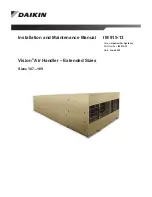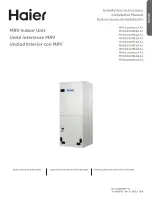
507746-01
Issue 1821
Page 13 of 39
•
It is recommended that the overflow drain line be
vented and a trap installed. Refer to local codes.
•
Condensate drain lines must be configured or provided
with a cleanout to permit the clearing of blockages and
for maintenance without requiring the drain line to be
cut.
Inspecting and Replacing Filters
Filter access door must be in place during unit operation.
Excessive warm air entering the unit from unconditioned
space may result in water blow-off problems.
IMPORTANT
Filters may be duct-mounted or installed in the cabinet. A
filter is installed at the factory. Note that filter access door
fits over access panel. Air will leak if the access panel is
placed over the filter door.
Filters should be inspected monthly and must be cleaned
or replaced when dirty to assure proper furnace operation.
To replace filter:
1.
Loosen the thumbscrews holding the filter panel in
place.
2.
Slide the filter out of the guides on either side of
cabinet.
3.
Insert new filter.
4. Replace panel.
See Table 5 for replacement filter sizes.
BCE7S
Filter Size – in. (mm)
24, 30, 36
20 x 20 x 1 (508 x 508 x 25)
42, 48, 60
20 x 24 x 1 (508 x 610 x 25)
Table 5.
Filter Dimensions
Sealing the Unit
There must be an airtight seal between the bottom of
the air handler and the return air plenum. Use fiberglass
sealing strips, caulking, or equivalent sealing method
between the plenum and the air handler cabinet to
ensure a tight seal. Return air must not be drawn from a
room where this air handler or any gas-fueled appliance
(i.e., water heater), or carbon monoxide-producing
device (i.e., wood fireplace) is installed.
WARNING
Seal the unit so that warm air is not allowed into the cabinet.
Warm air introduces moisture, which results in water blow-
off problems. This is especially important when the unit is
installed in an unconditioned area.
Make sure the liquid line and suction line entry points are
sealed with either the provided flexible elastomeric thermal
insulation, or field provided material (e.g. Armaflex,
Permagum or equivalent). Any of the previously mentioned
materials may be used to seal around the main and
auxiliary drains, and around open areas of electrical inlets.
Field Control Wiring
Wiring must conform to the current National Electric Code
ANSI/NFPA No. 70, or Canadian Electric Code Part I, CSA
Standard C22.1, and local building codes. Refer to following
wiring diagrams. See unit nameplate for minimum circuit
ampacity and maximum over-current protection size.
Electric Shock Hazard.
Can cause injury or death.
Foil-faced insulation has conductive characteristics
similar to metal. Be sure there are no electrical
connections within a ½ʺ of the insulation. If the foil-faced
insulation comes in contact with electrical voltage, the
foil could provide a path for current to pass through to
the outer metal cabinet. While the current produced
may not be enough to trip existing electrical safety
devices (e.g. fuses or circuit breakers), the current can
be enough to cause an electric shock hazard that could
cause personal injury or death.
WARNING
Run 24V Class II wiring only through specified low
voltage opening. Run line voltage wiring only through
specified high voltage opening. Do not combine voltage
in one opening.
WARNING
Select the proper supply circuit conductors in accordance
with tables 310-16 and 310-17 in the National Electric
Code, ANSI/NFPA No. 70 or tables 1 through 4 in the
Canadian Electric Code, Part I, CSA Standard C22.1.
Separate openings have been provided for 24V low
voltage and line voltage. Refer to the dimension illustration
of specific location.
Use copper conductors only.
CAUTION


































